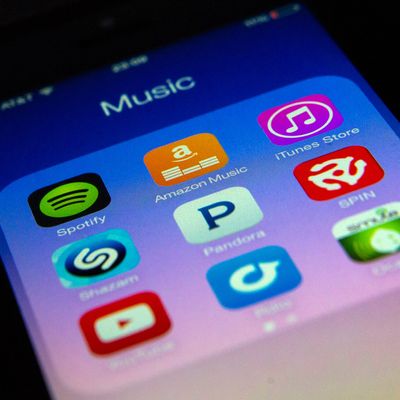
Reports of the music industry’s death have been greatly — or at least slightly — exaggerated. Yes, album sales are down from their peak of 785 million in 2000 to 476 million in 2014; and global music sales have fallen by $5 billion over the past decade; and, in theory, technology has given artists the tools to create, distribute, and promote their music without interference from traditional record companies. But the major labels have stubbornly continued to exist, even as old business models erode and listeners embrace streaming services like Spotify, Tidal, and Apple Music.
How is this possible? Though the occasional upstart manages to hit it big without a label (e.g., Rebecca Black), record companies still provide services for the majority of artists streamed on Spotify, and, given the chance, most musicians are still eager to sign with one. “These people are professionals,” says Russ Crupnick, founder of MusicWatch, an industry-analysis group. “Even assuming that you’re a good musician and have the time and interest to actually make a record, doing it yourself is the equivalent of sitting with a pencil and trying to do your own taxes.”
The three major labels — Sony, Universal, and Warner — remain deeply involved in deciding who hears what, often carefully engineering successes that seem viral or organic. Just this summer, Billboard blew the whistle on a Spotify payola pseudo-scandal: Labels were spending tens of thousands of dollars to get their songs on the service’s popular playlists. Spotify banned the practice, but the Big Three have other ways to get their artists heard. Each owns a playlist-curation service — Filtr (Sony), Digster (Universal), and Topsify (Warner) — that works within Spotify’s app and churns out mixes, featuring its artists, designed for driving, workouts, and other activities.
But what’s in this for the labels? Artists like Taylor Swift and Thom Yorke have complained about the meager royalties they receive from streaming — but their record companies actually make out pretty well on the deal. With Spotify, for example, labels get paid three different ways: First, they collect a lump-sum advance payment when they license their catalogue to the service. (Sony’s 2011 three-year deal with Spotify reportedly netted it an advance of $42.5 million, which it was not obligated to split with artists.) Second, a label gets a small payment every time one of its songs is streamed, a portion of which goes to the artists. (Spotify pays about 70 percent of its revenues to music owners.) And third, since Sony, Warner, and Universal are all investors in Spotify, they’ll cash in if Spotify should ever become profitable.
All of which is giving record labels hope, for the first time in a while, that digital revenues might someday make up some of what they lost when downloading overtook sales of physical media. The real-life music business won’t look like the one on Empire anytime soon — in 2002, more than 150 million Americans bought at least one CD; currently, only 8 million have a paid Spotify subscription — but it’s a start. “We’ve only scratched the surface in terms of monetizing streaming,” says Crupnick.
*This article appears in the September 7, 2015 issue of New York Magazine.





